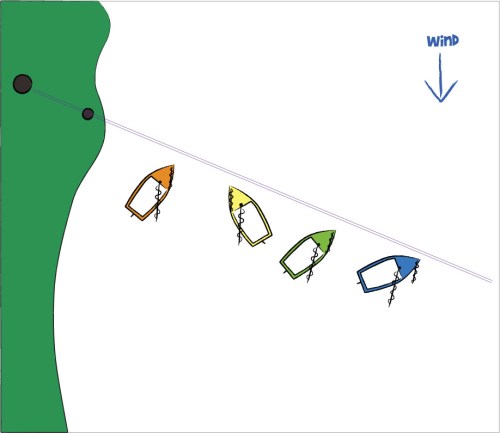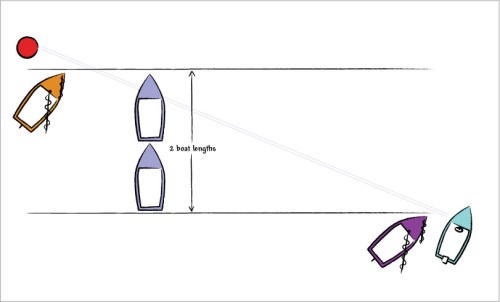Racing - Start Line Tactics
Go To: Sailing - Racing
Posted on 04 June 2009 18:04
Whats the best way off the line? Which way do you go? Find out all this and more in our article on starting tactics.
In our first article on Racing, we went over an introduction to all things racing - now we plan to expand on it. These articles still won't be as detailed as they could be - we have yet to cover the rules in detail on Caution Water, and the rules enter into every part of racing - we will cover basic rules, but will probably come back to visit advanced rules at a later date.
When first getting into racing, you'd be forgiven for thinking it's a case of get to the start line, race, finish - it's nowhere near that simple, and the tactics and preparation start at the start line. But first, some basic terms.
Most start lines have a pin end, and a committee or starting boat end. The pin end is typically a buoy or fixed point on the water, and the committee boat end is a safety boat of some sort that is monitoring the race start - the race may be started from this boat, or from a point on land, depending on the venue - obviously if a race is happening just off the coast, then the officers running the race will do it from safety boats, whereas if it's on a lake, they may do it from the warmth of a starters building or the clubhouse if it's next to the water.
An alternative method employed by some clubs is to use a transit system - two objects are placed on the side of the water, and the boats involved have to make a transit between the two objects as shown in the picture below - this is a transit between two points, and indicates the start line. This is typically used at smaller clubs.

Diagram 1: Transit System
Types of Start
There are two types of start - a line start, and a gate start. The line start is the most common, and this is the type that involves a pin end and committee boat end. These two ends are placed a certain distance apart (which depends on how many boats are taking part, the size of the venue etc), and when the whistle blows, or the flag signals change indicating the start of the race, all of the boats have to pass between these two ends of the line to start the race.
The second type of start, the gate start, is not as common. For this type of start, a powerboat travels along the length of the start line in front of the boats racing, and as the powerboat passes in front of you, you are allowed to start racing. Downsides to this include mostly the chance of hitting one of the starting boats, which can give you a penalty - plus you get disrupted water from the wake off the powerboat, which can be especially bad news on days without much wind as what little shape is in the sails can be knocked out by the waves you are sailing through.
Line starts can have their disadvantages too - for particularly large events with over a hundred boats taking part (several of the National Optimist races in the last few years have had over 300 entrants!), the start line can be especially long, and the conditions can vary along the length of the line, which makes your position even more tactical. We'll see more on this in a moment, when we talk about line bias.
How is the race started?
Races are usually started with a series of signals, either noise signals (a whistle or horn) at a set of intervals, or a series of flags are raised and lowered at set intervals, typically 5 minutes, then 4 minutes, then 1 minute, then race start. We'll look more at starting signals in the next article of this series.
Line Bias
So it doesn't matter which end of the line you start on, right? Wrong!
Depending on how the course is laid out, if you start on the left hand side of the line as in the diagram below, you are already closer to the first windward mark, and can sail a shorter distance than if you start on the right hand side of the start line. This should factor heavily into your tactics for deciding where to start on the start line. The race start line is rarely at a true right angle to the first mark - that is the windward mark is directly upwind of the start line as shown, and usually you will find one end is closer to the mark than the other - and the longer the start line is, the greater this advantage can be. This is known as line bias.

Diagram 2: Start Line Bias
However, consider this - if you start on the port end of a biased start line, and say you are two boat lengths closer to the mark, if the wind is stronger and more favourable on the other end of the start line, people starting the other end will be sailing into stronger wind, with more speed. Therefore, is is better to start at the end of the line nearest the wind (i.e. if the wind is coming from the left side, start at the port end of the line).
A good race officer will "bias" the start line by a small amount, say 5 degrees, that is, they will shift one end of the start line upwind slightly, and make the start line angled in relation to the first mark, rather than at right angles to it, as shown. This introduces slightly more in the way of tactical thinking required while you're battling for position on the start line.
Preferred side of the course
But, it's not just about where you start! There is usually a preferred side of the course. One of the most important things to do during pre-race preparation is to get out on the race course and sail it a few times before the race starts - this way you can figure out which side of the course is the better side to sail on.
In the diagram below, the purple boat has picked the side of the course which has a shorter route to the buoy - however, there is less wind on this side of the course. The red boat meanwhile has picked the other side of the course, which while slightly further to the first mark (buoy), has considerably more wind than the other side of the course - therefore the red boat gets to the first mark first.
Why would one side of the course be better than the other? There are various reasons why one side of the course may be better to sail on - it may have stronger wind or more gusts, it may have less currents or tide, or more room to manoevre meaning fewer tacks. Smaller lakes can often be surrounded by trees that can make wind patterns very shifty and hard to identify or monitor, leading to wildly varying wind conditions over the lake (on our lake, in one 10 x 10 metre spot in the middle the wind often does a complete 180 turnaround).
Features of the land can also cause differences in wind, particularly around headlands - we'll cover more on this in a later article. They don't have to be obvious either - when we were sailing in Greece, we were in a semi-sheltered bay, with a pretty consistent wind over the entire bay, yet even sailing in Lasers in a steady Force 2 morning breeze every race there was a faster side of the course to sail on - not alway faster by much, but you could definitely tell. All of these can mean one side of the course is better to sail on than the other.
Unfortunately, the only way to determine which side is the best side (apart from visually identifying key features such as headlands, or looking up maps that show tides and currents) is to get out on the course first thing, and find out for yourself.
But why is this important for start line tactics? We're talking about the rest of the race, aren't we? Yes, but the side of the course you want to sail on helps decide which end of the start line you wish to sail on. If you are going to come off the start line on port tack, then immediately tack onto starboard, you may be best starting at the port end of the start line, otherwise you may have lots of boats heading straight at you - you may well have right of way, but there are going to be a lot of angry sailors on those boats, some with bowsprits they can poke you with!
Starting Penalties
Once the whistle or flags go - you're off... that is, unless you did something wrong. If you were over the start line at the start of the race, this is known as OCS (On Course Side at start), and depending on the race rules, you can either be recalled back, in which case you have to sail back behind the start line, and cross it again (i.e. restart) - if you don't you will be disqualified even if you completed the race, or you can be disqualified straight away. Generally speaking, you are recalled to recross the start line. Sometimes if too many boats are over the start line before the race starts, the entire race start will be called off, and all the boats will start the countdown to the start again.
Summary
Believe it or not, this is again only an introduction to starting tactics - there are all kinds of detailed rules telling you how you can find a spot on the start line, who you're allowed to force out of the way and so on, but for now, if you've read through what's written above, you'll be better off than a lot of smaller club sailors!